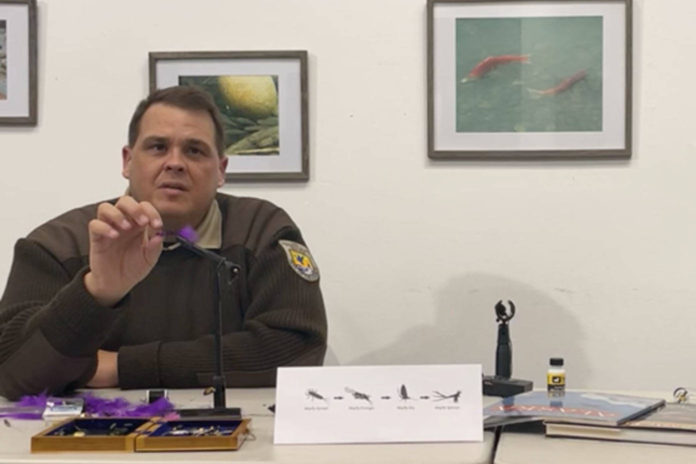The Kenai National Wildlife Refuge’s Matt Conner and Amber Kraxberger-Linson on Friday walked viewers through a step-by-step demonstration on how to make fishing flies during a virtual “Fishing and Fly Tying” workshop streamed in partnership with the Kenai Chamber of Commerce and Visitor Center.
Over the course of about an hour, Conner and Kraxberger-Linson provided detailed guidance on how to tie a wooly bugger fly, a flesh fly and a prince nymph fly.
Instead of going out and purchasing a box full of different flies, Conner said a worthier investment would be purchasing a fly-tying tool kit. For example, in constructing a wooly bugger, which imitates movement in water and is generally appealing to trout, Conner used a chenille and feathers. Chenille, he said, is a type of “fancy yarn.”
A key strategy in putting the fly together, Conner said, is to make sure that as the line is being wrapped around the hook that materials are secured between the thumb and forefinger. Otherwise, the line will pull the materials with it instead of securing them. Additionally, winding the line at an angle around the hook so that it is wrapped over itself can add extra security.
Another important strategy in making effective flies, Conner said, is to model it after the environment where someone is fishing.
“I start flipping over rocks and just looking to see what I find and what insects are out there,” Conner said. “Then I’ll see if I have anything in my box that can match the hatch or match the color.”
Kraxberger-Linson demonstrated how to tie a flesh fly, which is meant to imitate the carcasses of dead fish, like a piece of salmon floating downriver.
In building a flesh fly, Kraxberger-Linson used pale and neutral colored materials, like rabbit zonker. The same techniques as wrapping a wooly bugger should be used with flesh flies, though she noted that sometimes people lay down head cement for extra security.
“I am very new to fly tying, but it’s something I enjoy,” Kraxberger-Linson said. “Not all my flies are perfect but that’s OK, you know, you don’t need a perfect fly in order to catch fish — the saying is the perfect fly is the one that actually gets fish.”
Prince nymph flies are meant to look like insects and feature strategic wrapping that mimics body segments, additional materials to make features that look like wings and a forked end. The prince nymph fly, Kraxberger-Linson said, is a good universal fly.
“This is usually the one I kind of start with just because it’s so universal,” Kraxberger-Linson. “It’s great in clear water, fast-moving water, slow-moving water — if I have no idea … [I] just start throwing that one first and then move on from there.”
The full workshop can be viewed on the Kenai Chamber of Wildlife and Visitor Center’s Facebook page.
Credit: Source link































